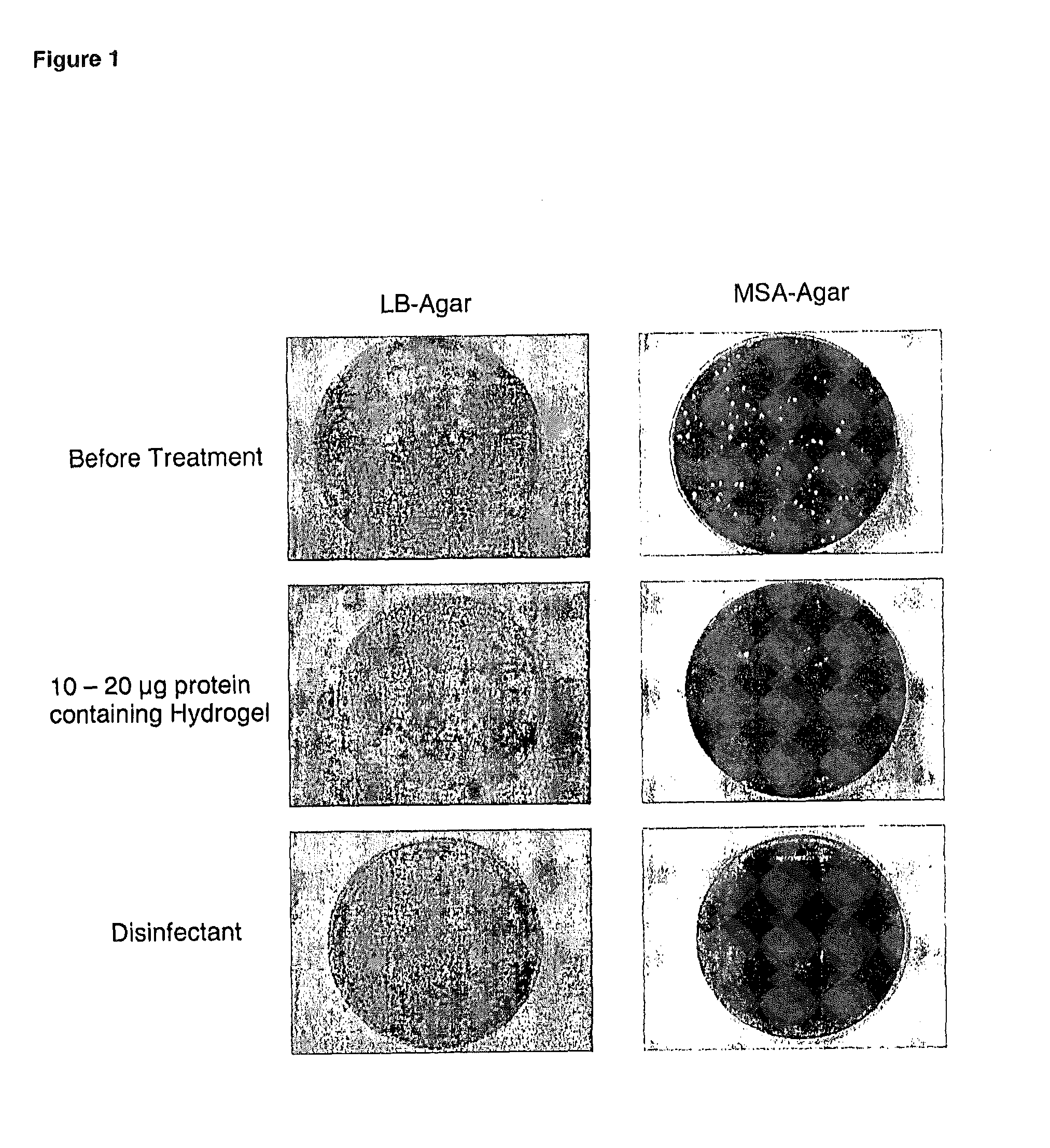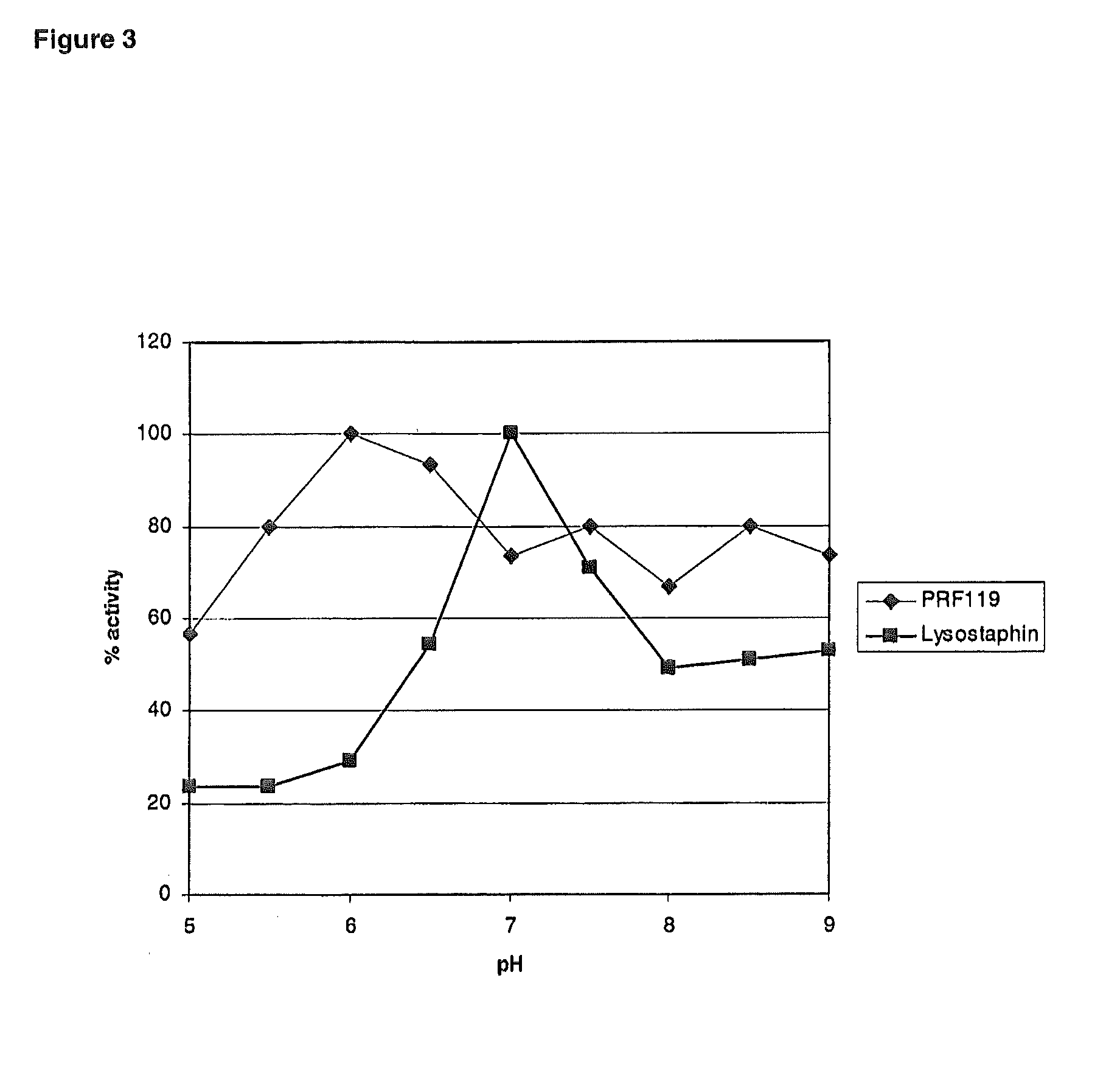Chimeric polypeptides and their use in bacterial decolonization
a polypeptide and bacterial technology, applied in the field of chimeric polypeptides, can solve the problems of high lysine concentration, poor solubility, and low lysine concentration, and achieve the effects of reducing the risk of resistance development, fast onset of action, and overcoming the increasing number of antibiotic resistance in bacteria
- Summary
- Abstract
- Description
- Claims
- Application Information
AI Technical Summary
Benefits of technology
Problems solved by technology
Method used
Image
Examples
example 1
Cloning of PRF115 / Sequence=CHAPlysK-Lysostaphin
[0128]PRF115 was cloned by “Splicing by overlap extension PCR” (SOE-PCR). In two separate PCR reactions, CHAPlysk and Lysostaphin were amplified, generating overlapping fragments, which are combined to the full length construct in a third PCR. CHAPlysk was amplified using pET14b_Lysk as a template with 5′T7promotor Oligonucleotide and a 3″Oligonucleotide annealing to the 3″-Terminus of the CHAP and containing 15 bases of the 5″-Terminus of Lysostaphin. Lysostaphin was amplified using pET14b_Lysostaphin as a template with a 5′Oligonucleotide annealing to the 5′-Terminus of Lysostaphin and containing 15 bases of the 3′-Terminus of CHAPlysk and 3′T7-Terminator Oligonucleotide. In a third PCR reaction, the overlapping fragments of the first PCRs were used as template and the full length PRF115 gene was amplified using T7-Promotor and T7-Terminator Oligonucleotides. The resulting PCR Product was (i) digested with NcoI and BamHI, ligated into...
example 2
Cloning of PRF119 / Sequence=CHAPlysK−CBDlysostaphin
[0130]PRF119 was cloned by “Splicing by overlap extension PCR” (SOE-PCR). In two separate PCR reactions, CHAPlysk and CBDLysostaphin were amplified, generating an overlapping area on both fragments. CHAPlysk was amplified using pET14b_Lysk as a template with 577-promotor Oligonucleotide and a 3′Oligonucleotide annealing to the 3′-Terminus of the CHAP that contained 15 bases of the 5′-Terminus of the CBD lysostaphin. CBDlysostaphin was amplified using pET14b_Lysostaphin as a template with a 5′Oligonucleotide annealing to the 5′-Terminus of the CBDlysostaphin and containing 15 bases of the 3′-Terminus of CHAPlysK and 3′T7-Terminator Oligonucleotide. In a second PCR reaction, the overlapping fragments of the first PCRs were used as template and the full length PRF119 gene was amplified using T7Promotor and T7-Terminator Oligonucleotides. The resulting PCR Product was (i) digested with NcoI and BamHI, ligated into pET14b and pQE60 respe...
example 3
Cloning of PRF102 / Sequence=CHAPlytN−CBDlysostaphin
[0132]PRF102 was cloned by “Splicing by overlap extension PCR” (SOE-PCR). In two separate PCR reactions, CHAPlytN and CBD lysostaphin were amplified, generating an overlapping area on both fragments.
[0133]CHAPlytN was amplified using pET14b_CHAPlytN as a template with 5′T7Promotor Oligonucleotide and an 3′Oligonucleotide annealing to the 3′-Terminus of the CHAPlytN that contained 15 bases of the 5′-Terminus of the CBDlysostaphin. CBDlysostaphin was amplified using pET14b_Lysostaphin as a template with a 5′Oligonucleotide annealing to the 5′-Terminus of the CBDlysostaphin and containing 15 bases of the 3′-Terminus of CHAPlytN and 3′T7Terminator Oligonucleotide. In a second PCR reaction, the overlapping fragments of the first PCRs were used as template and the full length PRF102 gene was amplified using T7Promotor and T7Terminator Oligonucleotides. The resulting PCR Product was (i) digested with NcoI and BamHI, ligated into pET14b and...
PUM
| Property | Measurement | Unit |
|---|---|---|
| concentration | aaaaa | aaaaa |
| concentration | aaaaa | aaaaa |
| pH | aaaaa | aaaaa |
Abstract
Description
Claims
Application Information
 Login to View More
Login to View More - R&D
- Intellectual Property
- Life Sciences
- Materials
- Tech Scout
- Unparalleled Data Quality
- Higher Quality Content
- 60% Fewer Hallucinations
Browse by: Latest US Patents, China's latest patents, Technical Efficacy Thesaurus, Application Domain, Technology Topic, Popular Technical Reports.
© 2025 PatSnap. All rights reserved.Legal|Privacy policy|Modern Slavery Act Transparency Statement|Sitemap|About US| Contact US: help@patsnap.com



